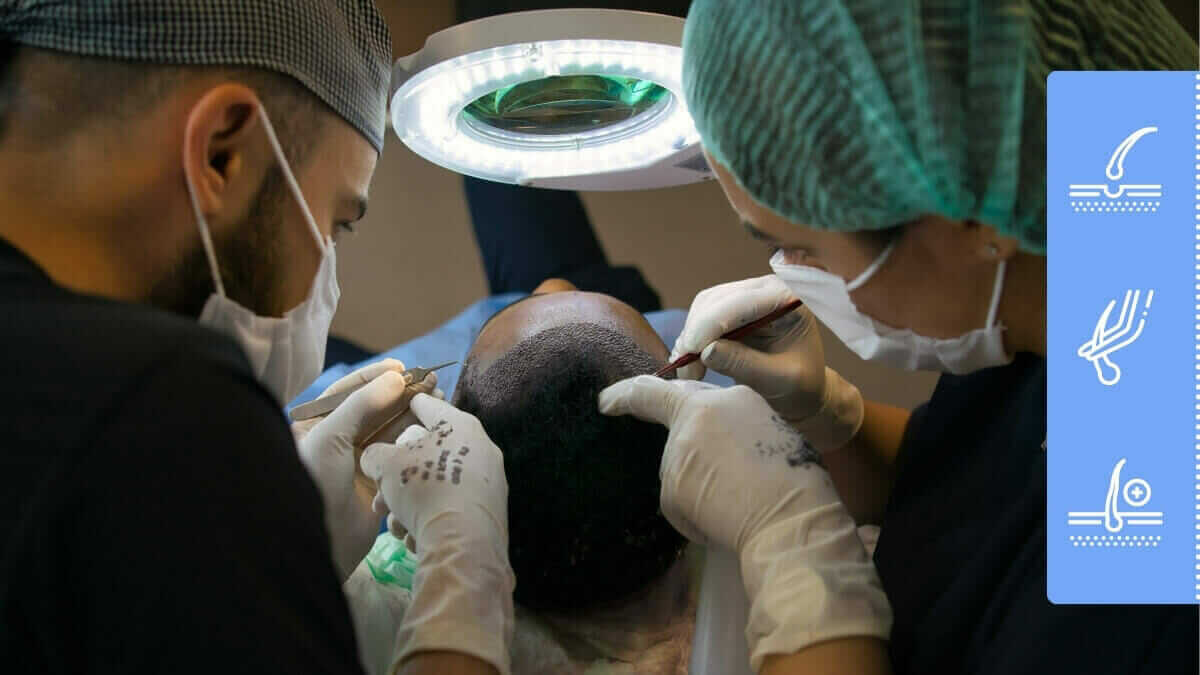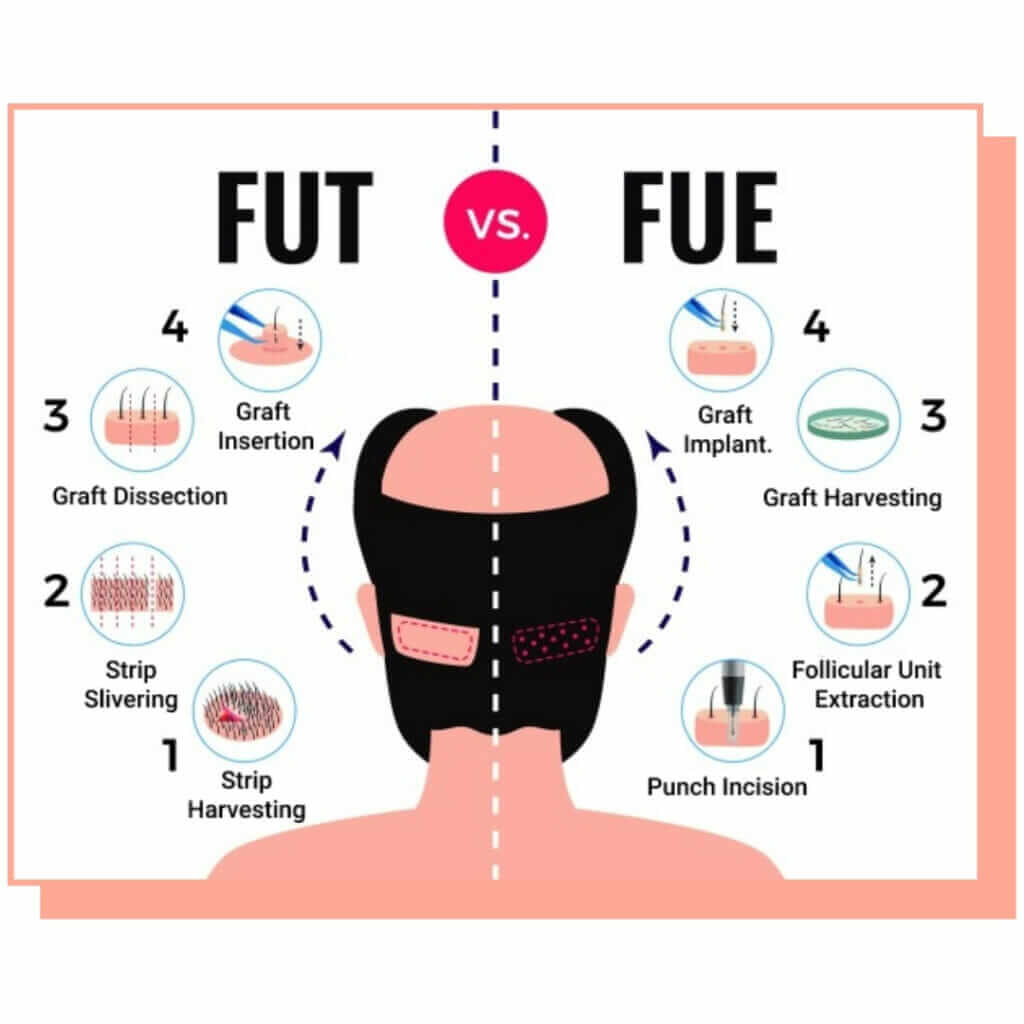According to Hair Society reports, over 650.000 people undergo hair transplant surgeries annually.
I can say that, as a dermatologist surgeon, most of these patients are aware of the complexity of this treatment and usually have a ton of questions.
TL;DR
➡ Hair transplants are hair restoration surgeries that transfer your existing hair from one part of your scalp to the balding areas.
➡ Every patient that fits the criteria of ages 25-65 will likely benefit from the 95% success chance of hair transplants.
➡ By choosing the right clinic with a dermatologist and the most successful methods, such as FUE, you can avoid having huge scars on your scalp and have a permanent solution.
If you’re balding and think that you might need to get a hair transplant but you have your doubts, I’ve compiled everything you need to know in this guide.
Table of Contents
- What is a hair transplant?
- Who is eligible for getting a hair transplant?
- Different Methods of Hair Transplant Surgeries
- 3 Stages of any Hair Transplant Procedure
- Benefits and Risks of Hair Transplant Surgeries
- How much does a hair transplant cost?
- Why UnitedCare?
- Conclusion
- Frequently Asked Questions (FAQs)
What is a hair transplant?
A hair transplant is a hair restoration surgical procedure that usually moves hair from one part of the scalp to another. A hair transplant surgery is best done by dermatologists, but you can come across plastic surgeons or hair restoration physicians who specialize in hair loss treatments too.
Why do people get a hair transplant?
The most common reason for getting a hair transplant is pattern baldness (androgenetic alopecia), especially in men. But we sometimes treat patients with scarring alopecia, burn injuries, or various other conditions that undergo hair transplant surgeries.
Of course, pattern baldness makes up the dominating majority of the patients and people choose getting hair transplants to restore lost hair in a specific area permanently.

Who is eligible for getting a hair transplant?
Eligibility for a hair transplant can be a bit tricky and might depend on the patient.
But, here are a few common qualities of people who can have a hair transplant:
- Patients ideally between the ages 25-65,
- Patients who have developed and set baldness,
- Patients with a donor area that is equal to or larger than the balding area.
- Overall healthy patients with thick enough hair and flexible scalps.
Who is not eligible for getting a hair transplant?
- Patients with active scarring alopecia.
- Patients who are younger than 25 with early, evolving and aggressive balding.
- Patients who don’t have enough grafts to be harvested due to a balding area that is larger than the donor area.
As I’ve said, your eligibility will most likely depend on your specific case. But if you meet most of the points above, you’re probably good to go for a hair transplant surgery.
But don’t forget that the wrong patient selection is one of the main reasons for hair transplant failures.
Physicians who are not experienced or who aren’t dermatologists might not have enough knowledge to understand your hair and skin type to make the right decisions and adjustments, so make sure you’re working with an experienced dermatologist for your hair transplant surgery.
Different Methods of Hair Transplant Surgeries
As with any field, since the first hair transplant surgery in 1952, new and more effective methods for hair transplantation were developed.
So let’s start with the oldest technique, and move towards the recent and popular techniques that are being used worldwide:
1- Hair Plug Technique
In 1952, an NYU dermatologist, Dr. Norman Orentreich, pioneered hair transplantation with the “hair plug” technique.
Of course, as it is with the first iteration of any procedure, the hair plug technique was more primal and not the most optimal method.
During a hair plug procedure, a large strip or area of hair and skin (around 4 millimeters) from the donor area (back of your scalp) is extracted and implanted into the bald areas.
These large extractions from the donor area resulted in unnatural end results, therefore made people look for better techniques.
Even though the harvested areas got smaller and smaller over the years to get better results, it was not enough to prevent modern techniques like FUT and FUE from taking over.
The hair plug technique is not practiced anymore and became obsolete.
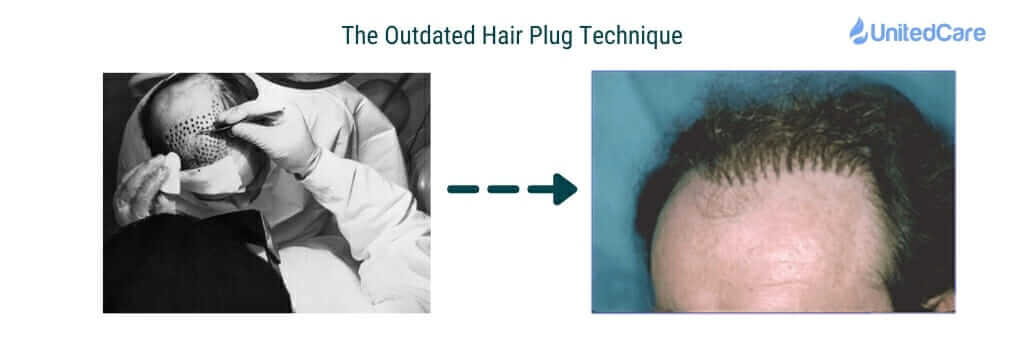
2- Follicular Unit Transplantation (FUT) Technique
In the early 1990s, Dr. Bobby Limmer, a dermatopathology specialist in Texas, US, performed the first follicular unit transplantation (FUT) operation.
In a Follicular Unit Transplantation, the surgeon extracts a strip of grafts from the donor area and implants it into the bald area. The FUT procedure takes around 4-6 hours.
The difference between the hair plug technique and the FUT technique is that instead of going for large areas, the FUT technique goes for thin strips of hair grafts to minimize scarring and make the end-product look as natural as possible.
But, even though it is much better than the hair plug technique, the FUT technique is known to leave thin and long scars in the donor area where the grafts were extracted. Skilled surgeons could minimize the damage and you could even cover up the scars with your hair, but there is a much better technique that leaves less scars at all if done right.
3- Follicular Unit Extraction (FUE) Technique
Dr. Ray Woods, a neurosurgeon who had prior experience in obstetrics, internal medicine, and cosmetic dermatology, performed the first follicular unit extraction (FUE) operation in 1989.
In a Follicular Unit Extraction (FUE) procedure, the surgeon uses a micro-punch tool to extract tiny amounts of hair follicles and then carefully implants them into the bald area. Since this is a more time-consuming and careful process, an FUE procedure takes around 6-8 hours.
Compared to the hair plug and FUT techniques, FUE procedures are done carefully on such a detailed level that the big majority of patients end up with natural-looking hair and experience almost no detectable scarring (by the eye) on the donor area at all.
Today, the majority of expert surgeons prefer the FUE technique simply because it provides much better results.
Sapphire FUE Technique
Sapphire FUE is done by using an expensive gemstone called sapphire.
Sapphire tip causes fewer wounds in the incision stage (it is used to open tiny punctures) and therefore it results in faster recovery and increased likelihood of success.
As experts in hair transplantation, we use these sapphire tips in FUE since we care about the best results possible.
4- Direch Hair Implantation (DHI) Technique
Direct Hair Implentation (DHI) method was invented at Kyungpook National University in Korea. The original implanter pen refers to Choi Implanter Pen developed there.
Differs from FUE in the implantation stage. In this method, Choi Implanter Pen is used to simultaneously open channels and implant grafts.
The operator can easily control the implant’s angle, direction, and depth using the special pen.
Increased precision makes this technique appealing even if it is more expensive than FUE.
In addition, DHI technique has a faster recovery period and can be performed with less bleeding compared to the FUE method.
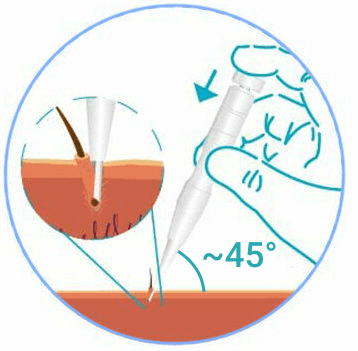
5- Robotic Hair Transplant Technique
In 2021, the inclusion of robotics for perfection in any field is unavoidable.
We’ve seen an increased number of expensive clinics using robotics to help them during hair transplant surgeries.
This technique does not actually adopt a brand-new method of hair transplantation, instead, it just removes the physicians from certain stages of the hair transplant surgeries. The most common of these stages being the extraction of the grafts.
The equipment first scans your donor area, determines the best parts for the grafts to be extracted from, and then harvests grafts. Usually, the next steps are done again by the surgeon, so there isn’t actually a completely robotic hair transplant technique yet.
Utilization of the robotic equipment in hair transplant surgeries promises a future where the surgeries are more precise and less fail-proof. But for the time being, they aren’t more effective than experienced surgeons and are just a marketing tool for most clinics.
Now that we know what the different methods for hair transplant surgeries are, let’s dive deeper into what the process really looks like for an average patient:
3 Stages of any Hair Transplant Procedure
All hair transplantation procedures progress very similarly, regardless of the technique used to extract and plant hair follicles.
As a dermatologist surgeon who has treated hundreds of patients through hair transplant surgeries, I would divide the process of hair transplantation into 3 stages: pre-surgery, surgery, and post-surgery.
I know when we say “hair transplantation” we refer to the actual surgery itself, which takes a couple of hours. But speaking from experience I can say that pre-surgery and post-surgery practices are much more crucial to the success of the hair transplant surgery than the actual surgery itself.

I’ll explain the importance of these stages as I walk you over what they look like:
Stage 1 – Pre-surgery
So let’s say you’ve decided you’re convinced, and you actually want to get a hair transplant.
Anything you do from this point onward will contribute to the success of the treatment. So even if you don’t have to watch your every step, be mindful of what you’re doing and what your physician suggests.
Consultation and Action Plan Suggestion
First things first, where will you get your hair transplant surgery?
The clinic and the surgeon can vary based on different factors, the most important ones being your location and your budget. Not every patient can afford a $20.000 hair transplant surgery in a luxurious clinic, so you’ll have to consider your options.
There’s no hurry, take your time. Most clinics offer free consultations, so consult a number of clinics before you make the decision. A few things to consider:
- Always opt for a dermatologist, simply because they’re skin and hair care experts who know the most about the complications that can occur.
- Compare the way different clinics approach you during the consultation process, if they’re trying to monetize the process as soon as possible, chances are, they’re not going to prioritize your health.
- Ask as many questions as you need, it’s the physician’s duty to inform you.
- Be mindful of the physician’s approach to your treatment, understand whether or not they’re experienced through the action plan they offer for your individual case.
If you’re not careful in your selection of a clinic and a physician, you might end up at the hands of inexperienced physicians who put money before your health.
Put your trust in a clinic that puts your health before anything else.
UnitedCare’s expert dermatologists are just one click away:
First Examination
Now that you’ve selected your clinic and physician, it’s time for you to go in for your first examination.
The physician has to make sure every issue is addressed and that you’re eligible for hair transplant surgery. The main topics that your physician will highlight during the examination are:
- The reasons behind your hair loss and how you should address these reasons to maximize the success of the operation.
- The steps and the procedure that will follow the first examination, what you should expect in the short and the long-term.
- The exact cost and the duration of the operation, which will be determined by the number of grafts that the physician will see fit for your situation.
During the first examination, you should be aware of how your physician approaches your situation and treatment. If they seem inexperienced, are unable to answer your questions, or seem inattentive; you have the right to stop the treatment and continue with another physician or clinic.
If you have doubts about your physician or think that they don’t prioritize your health, you shouldn’t proceed, not only in hair transplant surgeries but in every treatment procedure.
Stage 2 – Surgery
At this stage, you go through the actual surgery which starts with getting you ready for the operation, continues with the graft harvesting process, and ends with the successful graft implementation by the physician.
Since you’ve selected an attentive and experienced physician and a good clinic, you don’t need to do anything in this stage. Let your physician and their team take care of you.
If you’re getting an FUE, the whole surgery from start to end should take on average 6-8 hours.
2.1 – Drawing the Hairline and Anesthesia
This could also be done during the first examination, but since the physician needs a target area to work with, he suggests a new hairline for you.
Since your physician is an experienced surgeon, preferably a dermatologist, they will know the best target hairline for you, so accepting their suggestion is a clear choice.

After your hairline is drawn, your hair is shaved to the length that is the easiest to work with. Then you’re injected with tumescent anesthesia (a relatively safer way for delivering local anesthesia) to significantly reduce the pain during the surgery.
Usually, an injector with a needle is used, but dermojet, a needleless form of injection, can be used based on the patient’s choice. (Sedation option is also available but it requires an anesthesiologist, increasing the cost.)
2.2 – Graft Harvesting
Throughout the harvesting step, hair follicles from the donor area, which is usually the back of your scalp that has a good amount of hair, are extracted carefully.
Extracted follicles are stored in a proper liquid to keep them safe and ready to implant.
2.3 – Graft Implantation
And finally, the physician carefully implants the extracted follicles into the bald areas in your scalp, aiming to restore your hairline and create a natural look.
This is the part that takes the longest amount of time and the most effort, but most of the patients are very comfortable thanks to the local anesthesia during this stage.
Once the implementation is successful, the physician dresses the donor area where follicles were extracted, and you’re done.
Again, as an experienced dermatologist and hair transplant surgeon, I can say that the surgery stage of a hair transplant procedure is the least complicated from your end.
After the surgery, the physician should inform you of everything you should look out for in the future, at least the first few days before the first washing of your hair.
Stage 3 – Post-surgery
Now comes the stage that will require your utmost attention and care if you want your hair transplant to be a success story.
The success of a hair transplant surgery is determined by the percentage of grafts that remain on your scalp after a long period of time. To push that percentage to maximum, you need to help your scalp adopt the newly planted hair follicles by providing it with everything it might need.
The day or two after your surgery is complete, you’re called in for an examination:
Examination and First Wash
During the post-surgery examination, the physician undresses and examines the donor area as well as the bald area that the operation was done on. They inform you of the progress of both areas.
Then, the physician and their team wash your hair for the first time, explaining how you should do it in the future step-by-step.
And finally, they inform you about everything you need to know to make your hair transplant successful. They provide you with the products you’re going to use, explain how you will use them, tell you what to avoid, suggest a few habit changes to minimize the failure rate of the operation.
Follow-up
Most clinics that I know don’t do this, but I personally believe this is more important than most think…
The physician who has done the surgery should follow up with the patient, check in regularly, and comment on their progress.
Yes, as a patient, you can actually see the progress yourself but an experienced physician can analyze patterns more easily and let you know if there are any complications.
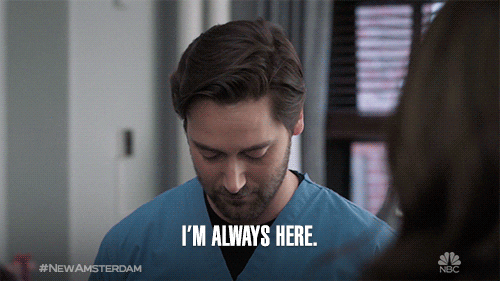
I’ve found the regular check-ins to be extremely beneficial to the recovery process. Even if your clinic doesn’t do regular check-ins, you should visit if possible, or send photographs of your scalp for the physician to see.
If you’re curious about what you should and shouldn’t do after a hair transplant surgery, read through our post-hair transplant recovery article, or just visit our care assistant tool.
If you go through each stage and step carefully, you should end up with natural-looking hair and a healthy scalp that has accepted most of the planted hair.
You can view our content on before and after photos of hair transplant surgeries to see the exact changes.
Benefits and Risks of Hair Transplant Surgeries
Again, as with any medical treatment, there are benefits of getting a hair transplant as well as risks to the process.
In this part, I want to dig deep into the benefits and risks of hair transplant surgeries and make sure I answer your remaining questions.
Starting with the good news:
Benefits of Hair Transplant Surgeries
Here are the main benefits of hair transplant surgeries:
1. Permanent Results
Do you know the coolest thing about hair transplantation?
Hair follicles taken from the side and back of the head KEEPS THEIR DHT RESISTANCE in the newly transplanted area making them permanent.
Therefore, hair transplant surgeries are permanent treatments if successful.
2. High Success Rate
These surgeries have a high success rate, due to the field being developed and studied for a long time.
In done by an experienced dermatologist hair transplant surgeon, the success rate goes up to 99%.
3. Advanced and Modern Treatment
Hair transplant surgeries are advanced and modern, due to the size of the industry and competition.
4. Natural Hair Growth
The hair growth is natural since it’s your own hair, so no one can tell you had surgery done unless you inform them of the procedure.
5. Much More Affordable
It is one of the most (if not the most) cost-effective treatments for hair loss, due to it being a permanent solution.
6. Minimum Side Effects
No side effects in most cases, since it is a basic and mechanical procedure.
7. The Hairline You Dreamed of
You restore the hairline you want, you don’t have to gamble as it is usually with other solutions. It is a direct treatment.
8. Quick Results
Compared to other treatments, a hair transplant yields results much quicker. You can see permanent progress in a matter of weeks.
9. One-and-done, mostly
A hair transplant surgery can be considered a one-and-done treatment, compared to most other methods. You don’t have to constantly visit the clinic for treatment sessions or adopt a long-term medication treatment.
10. Life-time Confidence Boost
Almost all my patients have told me that they’ve experienced a boost in their confidence, due to the quick, natural, and permanent results they’ve experienced.
11. More Studies to Rely On
Due to hair transplantation being a long-existing form of hair loss treatment, there are numerous studies you can find in the field that prove its effectiveness.
Risks of Hair Transplant Surgeries
And now, let’s talk bad news. Here are the most common risks for getting a hair transplant:
- There might be bleeding and even infections if there are any complications during and after the surgery.
- Nerve damage if the physician is not experienced and goes too deep during harvesting and implementation.
- Scars due to inexperienced physicians that aren’t careful in harvesting, or if you’re going with the FUT method.
- Hair loss failure (hair follicle fall out) due to various complications that can be caused by you, the physician, or the practices of the clinic.
What are the Side Effects of Hair Transplant Surgeries?
Finally, let’s talk about the hair transplant side effects that you might or might not experience, starting with the most common ones:
- Numbness throughout the scalp, due to local anesthesia.
- Pain and discomfort on the donor and the bald areas.
- Swelling, minimal bleeding, and bruising.
- Short-term scars in both the donor and the bald areas.
- Shock-loss a few weeks after the operation, due to the stressful operation that was done on the scalp.
Note that these side effects are natural and temporary. There aren’t any “additional” and unknown side effects like there might be with less practiced and experimental hair loss treatments.
How much does a hair transplant cost?
TL;DR – a hair transplant costs anywhere between $2,000 to $25,000, depending on the number of grafts and the location and pricing of your clinic.
Medihair executed a comprehensive study covering 90 clinics in 11 different countries. The results they found could be very useful to compare the prices and quality of clinics in various countries. The graft count is taken as 2500.
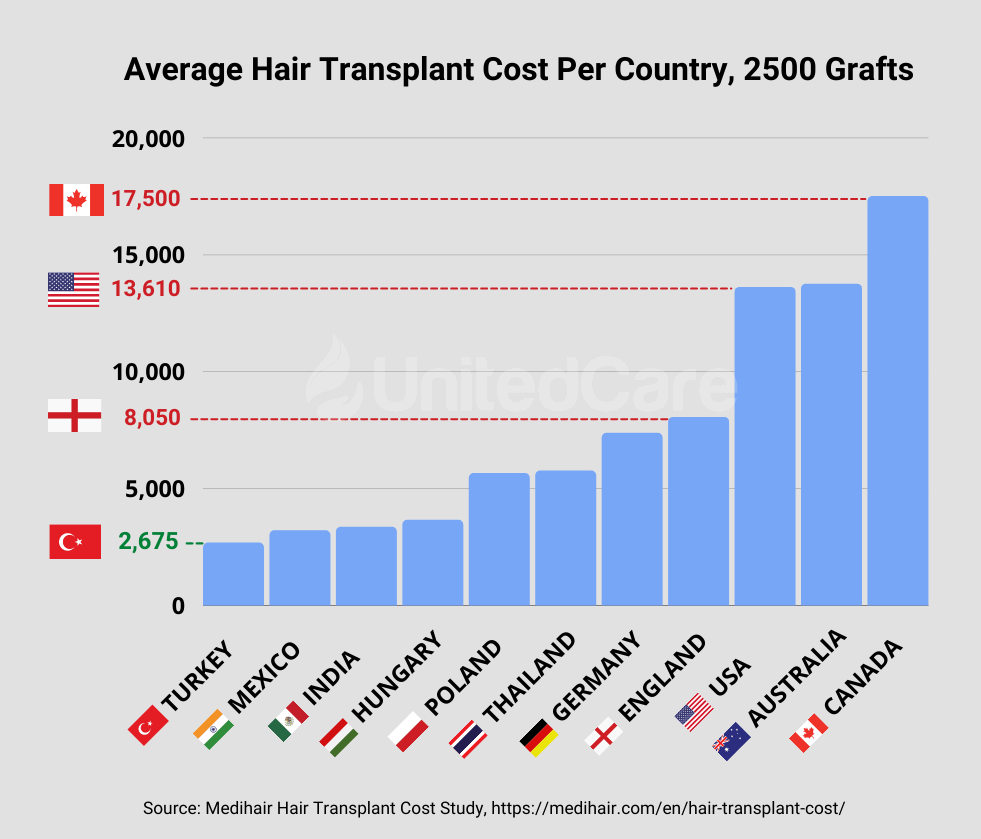
According to the chart, the order from the least expensive to most expensive is as follows:
- Turkey: $1.07 per graft
- Mexico: $1.28
- India: $1.34
- Hungary: $1.47
- Poland: $2.74
- Thailand: $2.30
- Germany: $2.93
- England: $3.22
- USA: $5.44
- Australia: $5.50
- Canada: $7.00
Let’s start to analyze some of the countries one by one, starting with the most popular:
1- Turkey Hair Transplant Surgery Costs:
Getting a hair transplant surgery in Turkey is much more popular than you think. I can confirm that as a dermatologist hair transplant surgeon in Istanbul, Turkey.
I’ve seen and treated hundreds of patients who came to Turkey from various parts of the world to get a hair transplant. This is usually because Turkey is more affordable than most countries and the hair transplantation clinics are way more advanced with internationally renowned surgeons.

For 2500 grafts, the average cost of a hair transplant in Turkey is $2675 and the average cost per graft is $1.07.
The price may actually vary between $1000-$12000 with most of the clinics at the lower end of this range.
2- Thailand Hair Transplant Surgery Costs:
Getting hair transplants in Thailand is also a very popular option for hair loss sufferers.
For 2500 grafts, the average cost of a hair transplant in Thailand is $5758 and the average cost per graft is $2.30.
The price range of hair transplantation clinics in this country starts at $1800 and can reach up to $8000, which covers the entire spectrum of affordable and luxury hair transplant centers that you might need depending on your budget or requirements.
3- India Hair Transplant Surgery Costs:
India hair transplant surgery costs are also very affordable, starting at $1000.
For 2500 grafts, the average cost of a hair transplant in India is $3350 and the average cost per graft is $1.34.
The price range goes up to $6000 depending on the location of your center and what you need in terms of quality or luxury features.
4- Mexico Hair Transplant Surgery Costs:
The hair transplant surgery costs in Mexico are slightly more expensive than in Turkey and India, starting at $2500.
For 2500 grafts, the average cost of a hair transplant in Mexico is $3201 and the average cost per graft is $1.28.
The price range of hair transplant clinics goes up to around $7000 depending on the location you choose for your clinic.

5- Poland Hair Transplant Surgery Costs:
The hair transplant surgery costs in Poland range from $3000 and go up to about $11000, which is still affordable.
The average cost of a hair transplant in Poland is $5646 and the average cost per graft is $2.74.
If you’re looking for a luxurious hair transplant clinic with all the bells and whistles at your disposal, then I’d recommend going with clinics like Hair Transplants Poland or Clinica Ruiz as they offer premium services as well as luxury rooms where patients can recover after their hair loss treatment.
6- Germany Hair Transplant Surgery Costs:
The average cost for a hair transplant in Germany is $4000, going up to $15000 if you choose a hair transplant center that’s on the luxury side.
For 2500 grafts, the average cost of a hair transplant in Germany is $7371 and the average cost per graft is $2.93.
Germany’s hair transplant surgery costs are slightly more expensive than in Poland or Turkey but still affordable compared to hair loss clinics in other parts of Europe and America.
7- UK Hair Transplant Surgery Costs:
Hair transplant surgery prices in the UK hair loss clinics range from $5000 and go up to around $25000.
For 2500 grafts, the average cost of a hair transplant in England is $8050 and the average cost per graft is $3.22.
8- Canada Hair Transplant Surgery Costs:
In Canada, hair transplant surgery costs start from $6000 and go as high as $30000 if you’re looking into getting one done by Dr. Parsa Mohebi’s clinic (the world-renowned leader in FUE techniques).
This is due to him being the only doctor who uses Artas Robotic hair transplant technology.
For 2500 grafts, the average cost of a hair transplant in Canada is $17500 and the average cost per graft is $7.
9- USA Hair Transplant Surgery Costs:
And finally, hair transplant surgery prices in the USA clinics range from $6000 and go all the way up to around $30000.
For 2500 grafts, the average cost of a hair transplant in United States of America is $13610 and the average cost per graft is $5.44.
Why UnitedCare?

For the average physician, and I’m saying this from experience, the priority during a hair transplant surgery is not your health or the success of the operation but the profit of the clinic.
As two dermatologist surgeons in Turkey, we’ve started UnitedCare to actually introduce an approach that assures the success of any hair transplant surgery by introducing a holistic method. This holistic method aims to address the causes of your hair loss and continue the treatment long after the surgery with regular checking to maximize the chances of success.
And all this without the exaggerated pricing of the luxurious clinics.
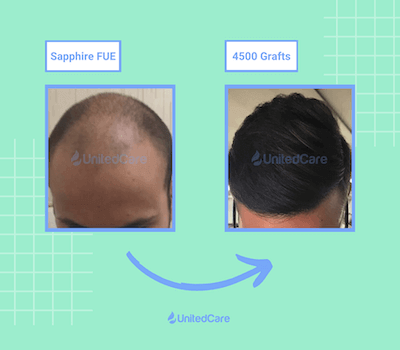
As I’ve suggested in this guide, make sure you get a bunch of free consultations before deciding on the physician, so why not start with us?
Put your trust in a clinic that puts your health before anything else.
UnitedCare’s expert dermatologists are just one click away:
Conclusion
Writing this guide, I’ve tried to answer all the questions my patients asked me over the years and to explain all the different practices there are.
A hair transplant surgery is a complicated process, but it is an effective treatment that I would suggest.
If you’re still wondering: Do Hair Transplants Work?
Frequently Asked Questions (FAQs)
What is the success rate of hair transplants?
Around 95% of hair transplant surgeries are successful, which means the majority of the grafts planted in the bald area don’t fall out after a long period and stay there permanently. The success rate increases to almost 99% at high-end clinics with experienced surgeons.
How permanent is a hair transplant?
If a hair transplant is successful, which means most of the planted grafts survive after a long time, they will stay there permanently. So, it is safe the say that most hair transplants are permanent solutions.
Is hair transplant painful?
During the hair transplant surgery, most patients feel very little pain thanks to local anesthesia (some even sleeps). During the days following the surgery, there can be mild pain in the scalp, but this pain can also be eliminated with light medication your physician will advise you.
What is the best age for hair transplants?
The perfect age for getting a hair transplant is between 25-65. Those older than these ages usually don’t have much hair left on the donor area, and those younger than these ages usually have ongoing and aggressive alopecia that didn’t set yet.
Do hair transplants look natural?
If you get a FUE hair transplant, which consists of a very careful process of extracting and planting grafts by an expert surgeon, your hair transplant will look like it is your natural hair. In most cases, other people won’t understand that you’ve had a hair transplant if you don’t tell them that you did.
Do hair transplants leave scars?
The Hair Plug technique in hair transplantation can leave huge scars throughout the scalp, the FUT technique can leave strips of scars in the donor area, but the FUE technique leaves minimal to non-detectable scars throughout your scalp.
